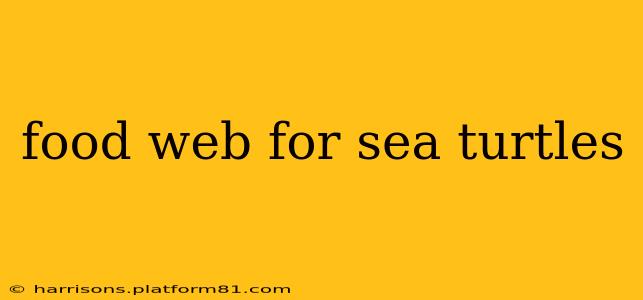Sea turtles, ancient mariners of the ocean, occupy a fascinating niche within complex marine food webs. Understanding their role requires examining their diet, their predators, and the broader ecosystem they inhabit. This exploration delves into the intricate relationships that shape sea turtle survival and highlights the importance of maintaining a healthy ocean environment.
What do sea turtles eat? (A Dietary Deep Dive)
Sea turtle diets vary significantly depending on species and age. However, they can be broadly categorized as herbivores, carnivores, or omnivores.
-
Herbivores: Green sea turtles are primarily herbivores, grazing on seagrass beds and algae. Their powerful jaws and specialized digestive systems allow them to efficiently process these plant materials.
-
Carnivores: Loggerhead sea turtles are primarily carnivores, feeding on a wide range of invertebrates like jellyfish, crabs, and shellfish. Hawksbill sea turtles also have a carnivorous diet, favoring sponges and other invertebrates.
-
Omnivores: Some sea turtle species, like Kemp's ridley sea turtles, are omnivores, consuming a mix of plants and animals. Their diet might include crustaceans, jellyfish, and seagrass depending on availability.
The specific food sources available in a given location greatly influence a sea turtle’s diet, showcasing the adaptability of these creatures.
What eats sea turtles? (Predators and Threats)
Sadly, sea turtles face numerous threats, and predation is one of them. While adult sea turtles have few natural predators, their vulnerability significantly increases during their early life stages.
-
Eggs and Hatchlings: Eggs are susceptible to predation by various animals, including crabs, birds, foxes, and even other reptiles. Once hatched, hatchlings face immediate dangers as they navigate their way to the ocean, becoming prey for birds, crabs, and fish.
-
Juveniles and Adults: Larger predators such as sharks, large predatory fish, and even some marine mammals might prey on juvenile and smaller adult sea turtles. However, these instances are relatively less frequent compared to the threats faced by younger turtles.
It's crucial to remember that human activities pose far greater threats to sea turtle populations than natural predators.
What are the main threats to sea turtles?
This question expands beyond just natural predators and touches upon the significant impact of human actions.
-
Habitat Loss and Degradation: Coastal development, pollution, and climate change severely impact sea turtle nesting grounds and foraging habitats. The destruction of seagrass beds and coral reefs directly affects their food sources.
-
Fishing Gear Entanglement: Sea turtles often get entangled in fishing nets and other gear, resulting in drowning or serious injuries. Bycatch is a significant contributor to sea turtle mortality.
-
Pollution: Plastic debris, chemical pollutants, and oil spills contaminate the ocean and negatively impact sea turtle health and survival. Ingesting plastic can lead to starvation and internal injuries.
-
Climate Change: Rising sea levels and changes in ocean temperature affect nesting sites and the sex ratio of hatchlings. Increased ocean acidity also impacts the availability of food sources.
How do sea turtles impact their ecosystem?
Sea turtles are keystone species, playing vital roles in maintaining the health and balance of marine ecosystems.
-
Seagrass Management: Herbivorous sea turtles help control seagrass growth, preventing overgrowth and maintaining biodiversity within seagrass meadows.
-
Nutrient Cycling: Their feeding habits and waste products contribute to nutrient cycling, enriching the marine environment.
-
Predator-Prey Relationships: Sea turtles form a crucial link in the food web, influencing populations of their prey and serving as prey for certain predators.
How can we protect sea turtles?
Protecting sea turtles requires a multi-pronged approach involving conservation efforts, legislation, and public awareness.
-
Protecting nesting beaches: Establishing protected areas, reducing light pollution, and minimizing disturbance around nesting sites are crucial for successful reproduction.
-
Reducing bycatch: Implementing turtle excluder devices (TEDs) in fishing nets helps reduce sea turtle entanglement.
-
Combating pollution: Reducing plastic use, improving waste management, and mitigating pollution sources are essential for a healthier marine environment.
-
Climate change mitigation: Addressing climate change through global efforts is necessary to safeguard sea turtle habitats and their survival in the long term.
Understanding the sea turtle food web is crucial for implementing effective conservation strategies. By recognizing their vital role in the marine ecosystem and the many threats they face, we can work towards a future where these magnificent creatures continue to thrive.
